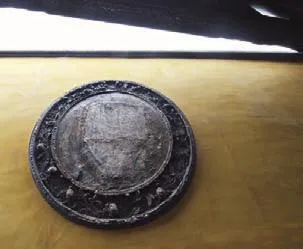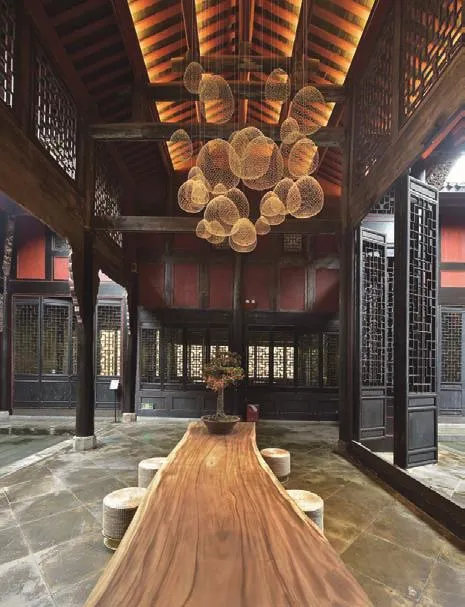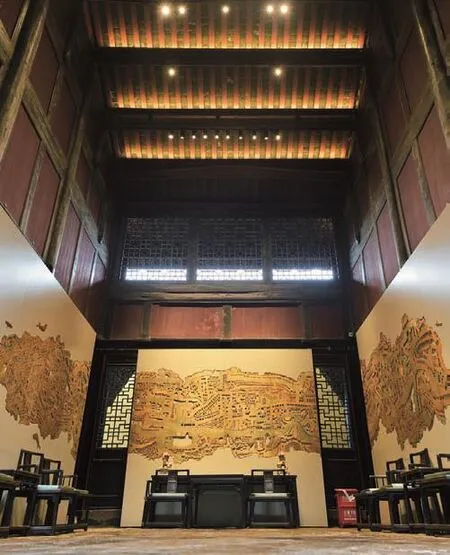清代雕花楼:重返的消逝时光
2018-08-08陈科龙
◇ 文|本刊记者 陈科龙 图| 游 宇
东水门至南纪门沿江一带的下半城,是重庆这座城市最为古老的城区。
早在数百年前,这一带连檐乌瓦之下,来自本帮外埠的客商贩夫、船工脚力,把重庆这片大码头营造得风声水起,热闹非凡。
彼时,贩夫船家们沿着江边码头石阶搭建起吊脚楼,比邻而居。那些家中殷实的富商巨贾,则在半山坡上,营造起山墙高耸的宽门大宅。
半个世纪以来,那些沿江层层叠叠的吊脚楼已所剩无几,那些雕镂精美的百年老宅也大都消逝。
所幸的是,道门口一处有着近三百年历史的老宅保存了下来。
Lower urban areas from Dongshuimen to Nanjimen along the Yangtze River are the oldest districts in Chongqing.
Hundreds of years ago, countless market transactions made by local boaters or merchants from other cities flourished this thriving city.
At that time, boaters and merchants built up their stilted buildings along the river-side wharf in close proximity. However, rich merchants set up their magnificent compounds on half hillside.
Over the half century, very few stilted buildings and exquisite compounds existed as time went on.
Fortunately, an ancient compound with a history of nearly three hundred years in Daomenkou, Yuzhong District is properly preserved.

西南首富“汤半城” The Richest Man in Western China—Tang Bancheng
仲夏,山城的阳光很好,照得人有些睁不开眼。从小什字经打铜街往道门口方向走,一路上人声鼎沸、车水马龙。
道门口公交车站对面的人行道旁,一面黄灿灿的土墙在阳光下甚是醒目。黄墙边上,“消逝的时光都让它重返”的广告语,温润,极具情怀。
一块黑色招牌上,“谢家大院”四个大字设计得颇有些现代感。从招牌左侧一条不起眼的小巷进去,沿着不到两米宽的石梯坎向下走十多步,就来到了谢家大院的大门前。
说到这座大院,不得不提到它曾经的两个主人:谢艺诚和汤子敬。
谢艺诚是江西临川人,祖辈明末清初时来到重庆。清同治年间,他开办的“谢亿泰”布行,是西南最大的布行,后来又把业务拓展到商行、钱庄,构筑起重庆最早的金融地图。

汤子敬则是谢艺诚的同乡,因兵祸致家道中落,从故乡流落到重庆。14岁时,他拜师谢艺诚,谢艺诚见其聪明笃厚,喜爱有加,手把手教其学艺。从管账、内事、跑街做起,汤子敬逐渐熟悉经商秘诀,成为谢艺诚的得力助手。
汤子敬30岁时,谢艺诚把女儿嫁给了他,并帮助他发展事业。擅于经营的汤子敬,逐渐成为重庆商界的泰斗,一度成为西南地区的首富,时称“汤百万”。
由于汤子敬大量投资购买宅院,其院落遍及重庆大街小巷,人称“汤半城”。
In midsummer, the sunshine of Chongqing is quite bright. Streets from Xiaoshizi to Daomenkou are jostled with large crowds and vehicles.
Beside the sidewalk opposite to Daomenkou Bus Stop, a cob wall shines brightly in sunlight. On the edge of the wall, a conspicuous slogan “Get Back to the Old Times” shows reminiscent of the past.
On a black signboard, four characters “Xie’s Family Compound (Xiejiadayuan)” are modern designed. Passing through a small lane on the left side of the signboard and walking down the stone ladder,we came to the gate of Xie’s Family Compound.
Speaking of this compound, I have to mention its two owners: Xie Yicheng and Tang Zijing.



Xie, born in Linchuan, Jiangxi Province, came to Chongqing with his ancestors in late Ming Dynasty. During Emperor Tongzhi’s reign in Qing dynasty, he opened a cloth store called “Xieyitai”,which was the largest cloth store in southwest of China. Later he expanded his business to various sectors, constructing the earliest financial map of Chongqing.
Tang was the fellow-villager of Xie and Xie took Tang as his apprentice when Tang was 14 by the virtue of his intelligence and sincerity. Starting from managing accounts, internal and commercial affairs, Tang became Xie’s favorite assistant after being familiar with the tricks of business.
Tang married Xie’s daughter at 30 and helped him develop business. Tang was skilled at operation and became a leading businessman in western China and was called “Millionaire Tang”.
Since his house properties spread all over Chongqing, he was also called “Tang Bancheng (half of the city)”.
匾额里的谢氏典故 The Tale of Xie’s Family
站在谢家大院门前的巷道,看着这挺立了三百年春秋的谢家大宅门,恍惚间给人一种“穿越时空”的感觉。与小巷上面热闹的街市相比,这里十分安静。
小巷子名唤太华楼巷,呈东西向,东起江边东水门码头,向上经过湖广会馆后,再西接旧时的丝绸绢帛集散地陕西路。虽地处昔日的繁华之地,但老巷子里却显得格外幽静,深深的石阶小巷山墙高耸,少有人家,更无商户,如今只有这谢家的宅院。
老宅的大门门楼呈八字形,青砖筑墙,条石砌门,大门两侧雕刻的喜鹊闹梅图栩栩如生。门旁分列雕花石门墩,朱红色大门上古铜色的门环完好无缺。



门上还悬有木架莲花门罩,虽说有些破旧,但还算保存较好,檐板、撑拱、垂花短柱等木构精雕细镂。大门上的匾额“宝树传芳”四个字虽然斑驳,但还能依稀辨认。
“宝树传芳”是有典故的。相传东晋谢安因淝水之战有功,当时孝武帝驾临谢安府邸,在庭院中看到一棵非常雄伟壮硕的大树,便指着那棵大树说:“此乃谢氏之宝树也。”于是,谢家堂号就以皇帝赐句为“宝树堂”。在唐代王勃的《滕王阁序》里也引用了这个典故:“非谢家之宝树,接孟氏之芳邻。”后来,各地谢姓人家开始将“宝树传芳”刻于大门门楣,作为家族荣光。
Embodied the beauty of peace and tranquil,Xie’s primitive compound gate gives us an illusion of time travel.
Taihualou Lane runs east to west. To the east lies Dongshuimen wharf and connects ancient silk distributing center by Huguang Guild Hall to the west. Although the lane with towering walls was prosperous in the old days, yet now it seems to be very quiet and solitary.

Lively magpies are carved on both sides of the magnificent splayed gate. Two stone plinths carved with various flowers and patterns separate the vermilion gate, with knockers properly preserved.
Exquisite wooden structures including lotusshaped cover, eaves board and short columns are also well preserved. Four characters “Baoshuchuanfang” carved on the gate tablet become blurred yet still recognizable.
“Baoshuchuanfang” has its literary allusion. It was said that Xie’an in Eastern Jin Dynasty made so great contributions to the success of Feishui Battle that Emperor Xiaowu personally came to Xie’s compound, where he saw a lofty tree and thought it was a tree of treasure. Therefore he granted Xie’s Hall as “Baoshutang”. This allusion was widely spread and all Xie’s family began to carve“Baoshuchangfang” on their lintel.

爱听戏的谢家人 Playgoers—Xie’s Family
进入大门后,是第二道石门。两道石门之间有一个小天井,也有叫过井的,过去有客拜见,下人进屋传话,客人就在此等候;主人作揖送客,也送到这里为止。
跨入两道石门后便入了宅院。大院分为前堂、后堂,分别有两处石板天井,天井内的石缸雕刻精美,盛满水,波光粼粼。前堂迎客、议事,后堂则是休息的地方,两侧是作卧室的厢楼,院子四角有木梯上下。同行的渝中区文管所工作人员告诉我们,当年谢艺诚家人住在楼上,丫鬟和佣人则住在楼下。
屋内朱红、墨黑交错,富贵而大气。飞檐上雕刻着精美的龙头鱼身和葡萄雕像,随处可见的雕花构建让人目不暇接。繁复的花鸟纹在柱头檐口间的额枋、雀替、牛腿上缠绕盘曲,穿插自如,令人不得不佩服古人高超的雕镂技艺。
院子中间有座雕花的阁楼,是昔日的小戏台。小戏台如今已被彻底封存了起来,里面没有了漂亮的花旦、小生,也听不见那些千古传唱的浪漫爱情戏。
一块额枋的正中,刻有一幅戏文故事,二十多个人物栩栩如生,据说画的是“铡美案”,包公审陈世美的戏文。
细细想来,刻下这幅“铡美案”,或许是喜欢听戏的谢家人,定是要汤子敬引以为戒,别学陈世美做那忘恩负义之人。
After entering the gate, the second stone-gate jumps into our eyes. Between the two gates lies a small open yard. In the past, this small yard was a place for message passing and seeing off.
Two flagstone open yards divide the compound into front and rear halls. Inside the yard, stone cylinders are filled with sparkling water. Every part of this compound is elaborately designed for different purpose, which reflects the essence of ancient people’s wisdom. Our companion, staff of Administration of Cultural Relics at Yuzhong District, told us that upstairs lived the family of Xie, and downstairs were their maids and servants.
Rooms are blazed with fantastic color and our eyes are dazzled by eaves carved with exquisite sculptures.The complexity of the flower-bird patterns twining around architrave, sparrow brace and bracket are indications of superb ancient craftsmanship.
In the middle of the compound lies a carved attic,which used to be a performance stage. Unfortunately,the attic is sealed up due to the preservation of cultural relics, so we fail to enjoy these romantic plays.
The center of an architrave is carved with more than 20 lifelike characters, among which Bao Zheng is interrogating Chen Shimei, usually known as“Chen Shimei’s Beheading Case”
Xie’s families are fans of classic plays. I was wondering maybe they hope this carving can remind Tang of learning lessons from Chen Shimei’s beheading case and always being grateful to his benefactors.
